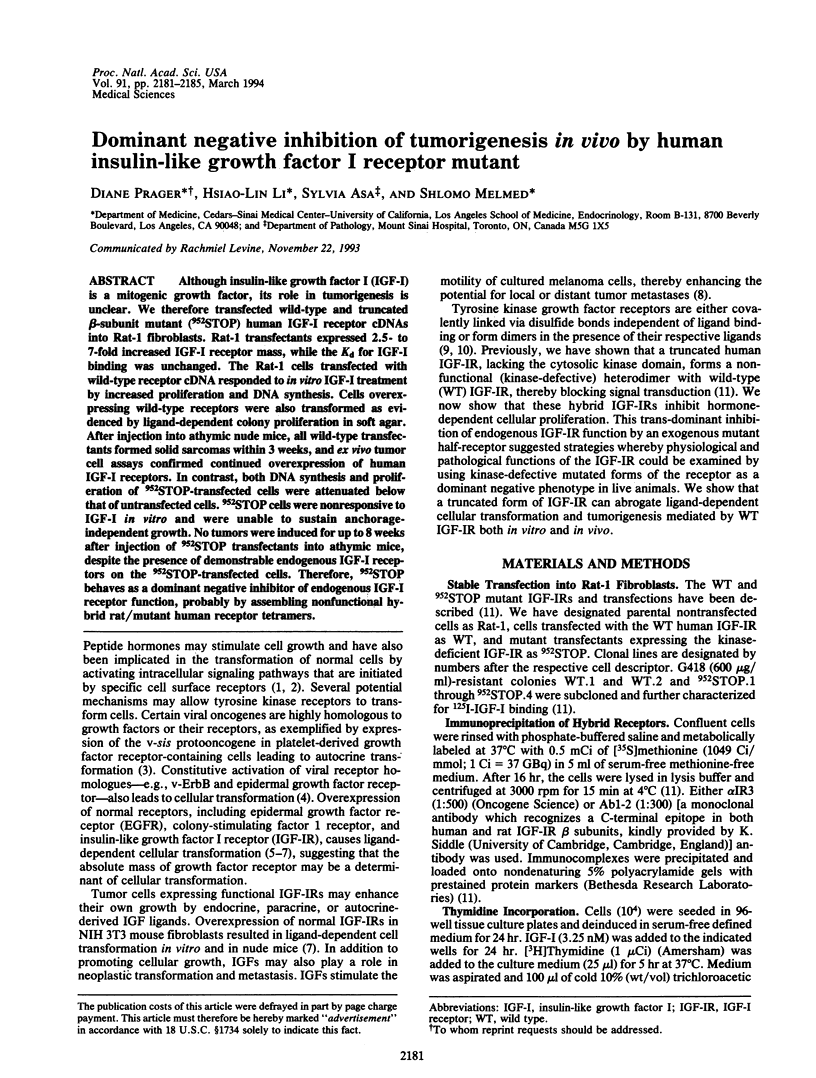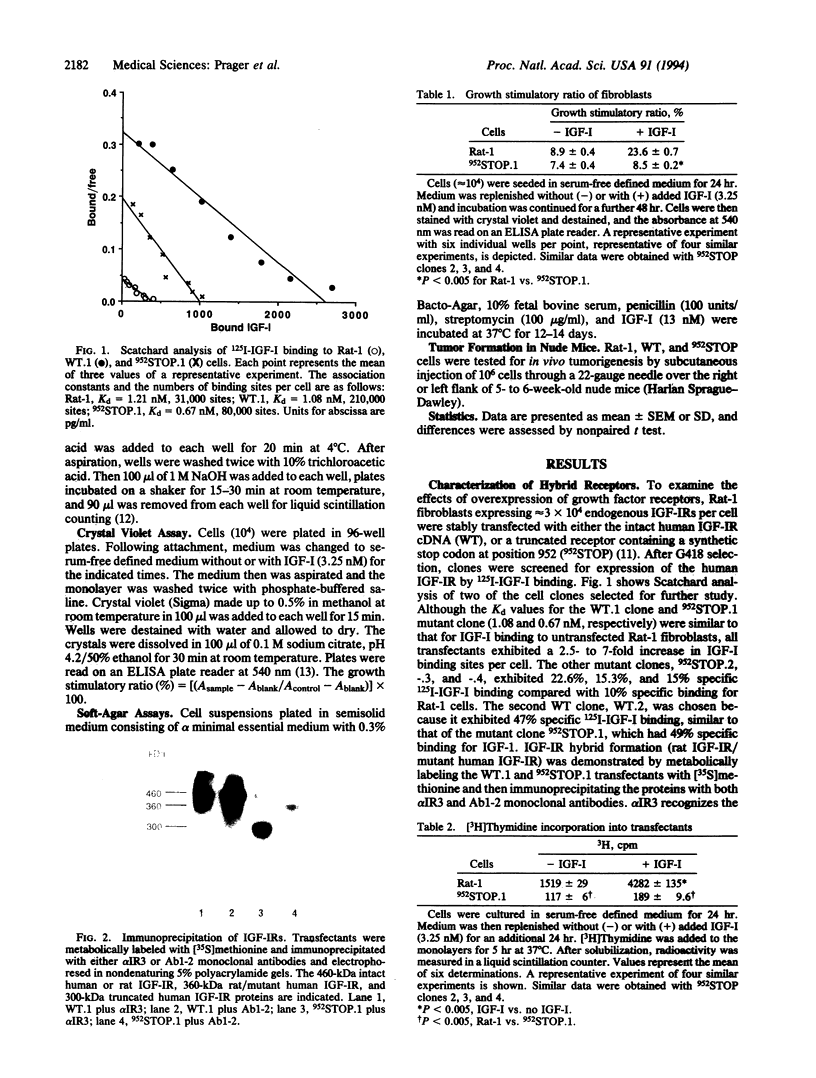Abstract
Although insulin-like growth factor I (IGF-I) is a mitogenic growth factor, its role in tumorigenesis is unclear. We therefore transfected wild-type and truncated beta-subunit mutant (952STOP) human IGF-I receptor cDNAs into Rat-1 fibroblasts. Rat-1 transfectants expressed 2.5- to 7-fold increased IGF-I receptor mass, while the Kd for IGF-I binding was unchanged. The Rat-1 cells transfected with wild-type receptor cDNA responded to in vitro IGF-I treatment by increased proliferation and DNA synthesis. Cells overexpressing wild-type receptors were also transformed as evidenced by ligand-dependent colony proliferation in soft agar. After injection into athymic nude mice, all wild-type transfectants formed solid sarcomas within 3 weeks, and ex vivo tumor cell assays confirmed continued overexpression of human IGF-I receptors. In contrast, both DNA synthesis and proliferation of 952STOP-transfected cells were attenuated below that of untransfected cells. 952STOP cells were nonresponsive to IGF-I in vitro and were unable to sustain anchorage-independent growth. No tumors were induced for up to 8 weeks after injection of 952STOP transfectants into athymic mice, despite the presence of demonstrable endogenous IGF-I receptors on the 952STOP-transfected cells. Therefore, 952STOP behaves as a dominant negative inhibitor of endogenous IGF-I receptor function, probably by assembling nonfunctional hybrid rat/mutant human receptor tetramers.
Full text
PDF




Images in this article
Selected References
These references are in PubMed. This may not be the complete list of references from this article.
- Carpenter G. Receptor tyrosine kinase substrates: src homology domains and signal transduction. FASEB J. 1992 Nov;6(14):3283–3289. doi: 10.1096/fasebj.6.14.1385243. [DOI] [PubMed] [Google Scholar]
- Chatterjee V. K., Nagaya T., Madison L. D., Datta S., Rentoumis A., Jameson J. L. Thyroid hormone resistance syndrome. Inhibition of normal receptor function by mutant thyroid hormone receptors. J Clin Invest. 1991 Jun;87(6):1977–1984. doi: 10.1172/JCI115225. [DOI] [PMC free article] [PubMed] [Google Scholar]
- Daughaday W. H. The possible autocrine/paracrine and endocrine roles of insulin-like growth factors of human tumors. Endocrinology. 1990 Jul;127(1):1–4. doi: 10.1210/endo-127-1-1. [DOI] [PubMed] [Google Scholar]
- Downward J., Yarden Y., Mayes E., Scrace G., Totty N., Stockwell P., Ullrich A., Schlessinger J., Waterfield M. D. Close similarity of epidermal growth factor receptor and v-erb-B oncogene protein sequences. Nature. 1984 Feb 9;307(5951):521–527. doi: 10.1038/307521a0. [DOI] [PubMed] [Google Scholar]
- Drummond I. A., Madden S. L., Rohwer-Nutter P., Bell G. I., Sukhatme V. P., Rauscher F. J., 3rd Repression of the insulin-like growth factor II gene by the Wilms tumor suppressor WT1. Science. 1992 Jul 31;257(5070):674–678. doi: 10.1126/science.1323141. [DOI] [PubMed] [Google Scholar]
- Heldin C. H., Ernlund A., Rorsman C., Rönnstrand L. Dimerization of B-type platelet-derived growth factor receptors occurs after ligand binding and is closely associated with receptor kinase activation. J Biol Chem. 1989 May 25;264(15):8905–8912. [PubMed] [Google Scholar]
- Kaleko M., Rutter W. J., Miller A. D. Overexpression of the human insulinlike growth factor I receptor promotes ligand-dependent neoplastic transformation. Mol Cell Biol. 1990 Feb;10(2):464–473. doi: 10.1128/mcb.10.2.464. [DOI] [PMC free article] [PubMed] [Google Scholar]
- Kohn E. C., Francis E. A., Liotta L. A., Schiffmann E. Heterogeneity of the motility responses in malignant tumor cells: a biological basis for the diversity and homing of metastatic cells. Int J Cancer. 1990 Aug 15;46(2):287–292. doi: 10.1002/ijc.2910460225. [DOI] [PubMed] [Google Scholar]
- Macaulay V. M., Everard M. J., Teale J. D., Trott P. A., Van Wyk J. J., Smith I. E., Millar J. L. Autocrine function for insulin-like growth factor I in human small cell lung cancer cell lines and fresh tumor cells. Cancer Res. 1990 Apr 15;50(8):2511–2517. [PubMed] [Google Scholar]
- Marcelli M., Zoppi S., Grino P. B., Griffin J. E., Wilson J. D., McPhaul M. J. A mutation in the DNA-binding domain of the androgen receptor gene causes complete testicular feminization in a patient with receptor-positive androgen resistance. J Clin Invest. 1991 Mar;87(3):1123–1126. doi: 10.1172/JCI115076. [DOI] [PMC free article] [PubMed] [Google Scholar]
- Melmed S. Acromegaly. N Engl J Med. 1990 Apr 5;322(14):966–977. doi: 10.1056/NEJM199004053221405. [DOI] [PubMed] [Google Scholar]
- Okajima T., Nakamura K., Zhang H., Ling N., Tanabe T., Yasuda T., Rosenfeld R. G. Sensitive colorimetric bioassays for insulin-like growth factor (IGF) stimulation of cell proliferation and glucose consumption: use in studies of IGF analogs. Endocrinology. 1992 Apr;130(4):2201–2212. doi: 10.1210/endo.130.4.1372238. [DOI] [PubMed] [Google Scholar]
- Pendergast A. M., Muller A. J., Havlik M. H., Maru Y., Witte O. N. BCR sequences essential for transformation by the BCR-ABL oncogene bind to the ABL SH2 regulatory domain in a non-phosphotyrosine-dependent manner. Cell. 1991 Jul 12;66(1):161–171. doi: 10.1016/0092-8674(91)90148-r. [DOI] [PubMed] [Google Scholar]
- Pietrzkowski Z., Wernicke D., Porcu P., Jameson B. A., Baserga R. Inhibition of cellular proliferation by peptide analogues of insulin-like growth factor 1. Cancer Res. 1992 Dec 1;52(23):6447–6451. [PubMed] [Google Scholar]
- Poon B., Dixon D., Ellis L., Roth R. A., Rutter W. J., Wang L. H. Molecular basis of the activation of the tumorigenic potential of Gag-insulin receptor chimeras. Proc Natl Acad Sci U S A. 1991 Feb 1;88(3):877–881. doi: 10.1073/pnas.88.3.877. [DOI] [PMC free article] [PubMed] [Google Scholar]
- Prager D., Yamasaki H., Weber M. M., Gebremedhin S., Melmed S. Human insulin-like growth factor I receptor function in pituitary cells is suppressed by a dominant negative mutant. J Clin Invest. 1992 Nov;90(5):2117–2122. doi: 10.1172/JCI116096. [DOI] [PMC free article] [PubMed] [Google Scholar]
- Redemann N., Holzmann B., von Rüden T., Wagner E. F., Schlessinger J., Ullrich A. Anti-oncogenic activity of signalling-defective epidermal growth factor receptor mutants. Mol Cell Biol. 1992 Feb;12(2):491–498. doi: 10.1128/mcb.12.2.491. [DOI] [PMC free article] [PubMed] [Google Scholar]
- Roussel M. F., Dull T. J., Rettenmier C. W., Ralph P., Ullrich A., Sherr C. J. Transforming potential of the c-fms proto-oncogene (CSF-1 receptor). Nature. 1987 Feb 5;325(6104):549–552. doi: 10.1038/325549a0. [DOI] [PubMed] [Google Scholar]
- Schally A. V. Oncological applications of somatostatin analogues. Cancer Res. 1988 Dec 15;48(24 Pt 1):6977–6985. [PubMed] [Google Scholar]
- Sugarman B. J., Aggarwal B. B., Hass P. E., Figari I. S., Palladino M. A., Jr, Shepard H. M. Recombinant human tumor necrosis factor-alpha: effects on proliferation of normal and transformed cells in vitro. Science. 1985 Nov 22;230(4728):943–945. doi: 10.1126/science.3933111. [DOI] [PubMed] [Google Scholar]
- Taylor S. I., Cama A., Accili D., Barbetti F., Imano E., Kadowaki H., Kadowaki T. Genetic basis of endocrine disease. 1. Molecular genetics of insulin resistant diabetes mellitus. J Clin Endocrinol Metab. 1991 Dec;73(6):1158–1163. doi: 10.1210/jcem-73-6-1158. [DOI] [PubMed] [Google Scholar]
- Treadway J. L., Morrison B. D., Soos M. A., Siddle K., Olefsky J., Ullrich A., McClain D. A., Pessin J. E. Transdominant inhibition of tyrosine kinase activity in mutant insulin/insulin-like growth factor I hybrid receptors. Proc Natl Acad Sci U S A. 1991 Jan 1;88(1):214–218. doi: 10.1073/pnas.88.1.214. [DOI] [PMC free article] [PubMed] [Google Scholar]
- Ueno H., Gunn M., Dell K., Tseng A., Jr, Williams L. A truncated form of fibroblast growth factor receptor 1 inhibits signal transduction by multiple types of fibroblast growth factor receptor. J Biol Chem. 1992 Jan 25;267(3):1470–1476. [PubMed] [Google Scholar]
- Velu T. J., Beguinot L., Vass W. C., Willingham M. C., Merlino G. T., Pastan I., Lowy D. R. Epidermal-growth-factor-dependent transformation by a human EGF receptor proto-oncogene. Science. 1987 Dec 4;238(4832):1408–1410. doi: 10.1126/science.3500513. [DOI] [PubMed] [Google Scholar]
- Waterfield M. D., Scrace G. T., Whittle N., Stroobant P., Johnsson A., Wasteson A., Westermark B., Heldin C. H., Huang J. S., Deuel T. F. Platelet-derived growth factor is structurally related to the putative transforming protein p28sis of simian sarcoma virus. Nature. 1983 Jul 7;304(5921):35–39. doi: 10.1038/304035a0. [DOI] [PubMed] [Google Scholar]
- Wilden P. A., Siddle K., Haring E., Backer J. M., White M. F., Kahn C. R. The role of insulin receptor kinase domain autophosphorylation in receptor-mediated activities. Analysis with insulin and anti-receptor antibodies. J Biol Chem. 1992 Jul 5;267(19):13719–13727. [PubMed] [Google Scholar]
- Yagi H., Ozono K., Miyake H., Nagashima K., Kuroume T., Pike J. W. A new point mutation in the deoxyribonucleic acid-binding domain of the vitamin D receptor in a kindred with hereditary 1,25-dihydroxyvitamin D-resistant rickets. J Clin Endocrinol Metab. 1993 Feb;76(2):509–512. doi: 10.1210/jcem.76.2.8381803. [DOI] [PubMed] [Google Scholar]
- Yamasaki H., Prager D., Melmed S. Structure-function of the human insulin-like growth factor-I receptor: a discordance of somatotroph internalization and signaling. Mol Endocrinol. 1993 May;7(5):681–685. doi: 10.1210/mend.7.5.8316251. [DOI] [PubMed] [Google Scholar]
- van Rijswijk R. E., van Loenen A. C., Wagstaff J., Meijer E., Lopez R., van Groeningen C. J., Heimans J. J., Pinedo H. M. Suramin: rapid loading and weekly maintenance regimens for cancer patients. J Clin Oncol. 1992 Nov;10(11):1788–1794. doi: 10.1200/JCO.1992.10.11.1788. [DOI] [PubMed] [Google Scholar]




